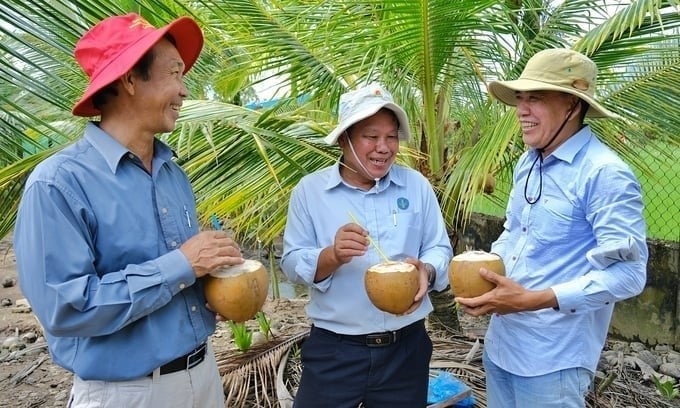December 6, 2025 | 14:40 GMT +7
December 6, 2025 | 14:40 GMT +7
Hotline: 0913.378.918
December 6, 2025 | 14:40 GMT +7
Hotline: 0913.378.918
Once overlooked in national agricultural strategies, coconuts, particularly fresh coconuts, have risen to become one of Vietnam's key exported fruits, ranking just behind durian and dragon fruit.
After more than a decade of efforts by local governments, businesses, and the Vietnam Coconut Association, this fruit, closely tied to the cultural life of southern Vietnam, is gradually establishing a new position on the agricultural export map.

Ms. Tran Le Hoa, Deputy Head of the Department of Social Sciences (Vietnam Coconut Association). Photo: Nguyen Thuy.
According to the Plant Production and Protection Department, fresh coconut exports in 2024 reached USD 390 million, accounting for 31% of the total coconut export turnover. Notably, the world's two largest markets, the U.S. and China, have officially welcomed Vietnamese fresh coconuts.
This transformation is the result of coordinated efforts by multiple stakeholders. From a fragmented industry, primarily based on intercropping in household gardens, Vietnam's coconut industry has developed into a complete value chain with over 250 processing facilities, including 80 deep-processing enterprises. Large-scale coconut farms have also begun to emerge, driving increased demand for varieties, cultivation techniques, and infrastructure investment.
However, to sustain its growth momentum and compete with coconut powerhouses such as Thailand, the Philippines, and Indonesia, Vietnam's coconut industry must overcome several bottlenecks.
Ms. Tran Le Hoa, Deputy Head of the Department of Social Sciences under the Vietnam Coconut Association, pointed out that one key challenge is the small scale of coconut production. While coconuts are currently grown in 16 provinces and cities, intercropping remains the dominant cultivation method, making it difficult for enterprises to procure coconuts with consistent varieties, sizes, and quality.
Transportation is another issue, as the fruit is still mainly delivered by motorbikes and rudimentary boats, driving up logistics costs. Meanwhile, post-harvest preservation remains outdated, with temporary storage facilities operated by smallholder farmers.
In addition, Vietnam's coconut brand remains weak compared to regional competitors. While Thailand has developed automatic packaging lines and standardized labeling systems, most Vietnamese coconuts are still manually pre-processed. Weak brand recognition puts Vietnamese coconuts at a disadvantage on international retail shelves, despite their comparable quality.

The coconut industry holds significant potential for development. Photo: Bao Thang.
In light of this reality, Ms. Hoa emphasized the urgent need to establish a legal corridor for centralized coconut farming models, facilitating access to credit and participation in official export chains.
Another fundamental solution is standardizing coconut varieties. Localities should coordinate with cooperatives and businesses to identify and certify elite varieties and provide guidance on breeding to ensure quality and adaptability to each ecological zone.
Additionally, developing care and fertilizer management procedures is necessary to avoid unsustainable intensive farming that may affect coconut water quality, which is a critical factor for fresh coconuts.
Developing regional brands is also an essential step, to be carried out in parallel with the restructuring of production. Each coconut variety should be clearly identified with a geographical indication, ownership information, and a planting area code. Promotional activities at international trade fairs, along with connections to e-commerce platforms and major importers, need to be conducted more systematically and methodically.
Since 2023, the Vietnam Coconut Association has piloted a dedicated Zalo communication channel to update purchasing demand from foreign partners. This is a small but practical step to support small and medium-sized enterprises.
At the strategic level, integrating coconuts into the national action program for the development of key industrial crops serves as a critical foundation. This move would not only harmonize zoning plans for cultivation areas but also provide the basis for Ministries and branches to issue priority policies on investment in infrastructure, logistics, processing, and science and technology.
According to Ms. Hoa, a positive sign in recent times is the growing number of Vietnamese enterprises investing in technologies and new products, from whole coconuts and diamond-cut coconuts to laser-engraved coconuts. Thanks to these efforts, Vietnamese coconuts are now present in over 40 countries. However, to maintain their market position, products must demonstrate greater consistency in quality and design, and above all, a brand story attractive enough to touch global consumers.
Amid the current global economic downturn, consumers increasingly pay attention to the sustainable value of products. Coconuts are not just a beverage; they also represent the land, culture, and people of Vietnam. If these intangible values can be effectively harnessed, Vietnam’s coconut industry will not only expand its export markets but also contribute to spreading national identity through every finished coconut product.
Vietnam currently has approximately 200,000 hectares of coconuts, ranking 7th in the world in terms of growing area. With a short fruiting cycle, coconuts generate high profits and are easily processed and consumed in a variety of forms. Moreover, by-products like coconut coir and leaves have wide-ranging applications in processing, handicrafts, and as growing media in crop production.
Translated by Thu Huyen

(VAN) Despite numerous challenges, Vietnam's key seafood products are maintaining strong momentum, setting the stage for full-year exports to potentially reach USD 11 billion.

(VAN) The signing of a protocol between Viet Nam and China on the export of fresh jackfruit represents a significant milestone in agricultural trade cooperation between the two countries.

(VAN) On November 27, the Ninh Binh Department of Agriculture and Environment and the Institute for Green Growth Research organized a training course on greenhouse gas inventory for businesses.

(VAN) China’s cooking oil is suddenly flooding into India. It all comes down to a soybean surplus that Beijing doesn’t quite know what to do with.

(VAN) An Giang promotes supply-demand connections, standardizes quality and builds value chains, creating a foundation for sustainable bird’s nest development and aiming to expand exports.
/2025/11/24/5339-4-nongnghiep-075331.jpg)
(VAN) Recently, the conference on 'Sustainable Fisheries Linkage Chain - Tilapia for Export' took place in Tien Hai commune, Hung Yen province.
/2025/11/21/4309-2-153400_128.jpg)
(VAN) Green and low-emission rice is paving the way for Vietnamese rice to enter high-end markets, marking the beginning of a transformation journey toward greening and elevating the national rice brand.